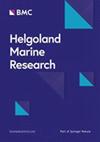波罗的海首次发现非本土水母Blackfordia virginica (Mayer, 1910)
4区 地球科学
Q2 Agricultural and Biological Sciences
引用次数: 1
摘要
海洋生物入侵日益成为全球生物多样性保护关注的焦点。凝胶状的大型浮游动物含有具有全球入侵性的成员,例如栉水母(Mnemiopsis leidyi)或水水母(Blackfordia virginica)。处女海蛞蝓的特点是耐盐性强,在半咸水环境中生存,并在有性繁殖的浮游水母和无性繁殖的底栖珊瑚虫之间交替,以完成生命周期。在本研究中,我们分析了基尔运河8年(2010-2017年)的浮游鱼调查数据和波罗的海中部14年(2008-2017年)的夏季浮游鱼调查数据。我们报告了在北欧,即来自波罗的海西南部和基尔运河的处女b的首次存在。在基尔运河,2014年和2015年首次零星发现了处女座小蠊,并自2016年夏季以来形成了持久的种群。2016年夏季,粒径-频率分布的变化表明,基尔运河在盐度为7 ~ 13、温度> 14°C的情况下正在积极招募。2017年,在波罗的海西南部,人们观察到b.f invirica靠近并与之直接相连,这表明波罗的海和北欧其他半咸水栖息地正面临着这种非本地物种殖民化的风险。我们的研究结果强调,监测活动应该考虑将胶状大型浮游动物作为标准评估,以便在非本地物种殖民化的早期阶段检测到它们。本文章由计算机程序翻译,如有差异,请以英文原文为准。
First record of the non-indigenous jellyfish Blackfordia virginica (Mayer, 1910) in the Baltic Sea
Marine invasions are of increasing concern for biodiversity conservation worldwide. Gelatinous macrozooplankton contain members, which have become globally invasive, for example the ctenophore Mnemiopsis leidyi or the hydromedusae Blackfordia virginica. B. virginica is characterised by a large salinity tolerance, with a brackish-water habitat preference, and by a metagenic life history strategy with an alternation between sexually reproducing planktonic medusae and asexually reproducing benthic polyps to complete the life cycle. In this study we analysed 8 years of ichthyoplankton survey data (2010–2017) from the Kiel Canal and 14 ichthyoplankton summer surveys in the central Baltic Sea (2008–2017). We report the first presence of B. virginica in northern Europe, namely from the southwestern Baltic Sea and the Kiel Canal. In the Kiel Canal, B. virginica was first sporadically sighted in 2014 and 2015 and has developed persistent populations since summer 2016. Changes in size-frequency distributions during summer 2016 indicate active recruitment in the Kiel Canal at salinities between 7 and 13 and temperatures > 14 °C. Close vicinity to and direct connection with the southwestern Baltic Sea, where B. virginica was observed during 2017, indicate that the Baltic Sea and other brackish-water habitats of Northern Europe are at risk for colonisation of this non-indigenous species. Our results highlight that monitoring activities should consider gelatinous macrozooplankton for standard assessments to allow for the detection of non-indigenous species at an early stage of their colonisation.
求助全文
通过发布文献求助,成功后即可免费获取论文全文。
去求助
来源期刊

Helgoland Marine Research
地学-海洋学
自引率
0.00%
发文量
0
审稿时长
6-12 weeks
期刊介绍:
Helgoland Marine Research is an open access, peer reviewed journal, publishing original research as well as reviews on all aspects of marine and brackish water ecosystems, with a focus on how organisms survive in, and interact with, their environment.
The aim of Helgoland Marine Research is to publish work with a regional focus, but with clear global implications, or vice versa; research with global emphasis and regional ramifications. We are particularly interested in contributions that further our general understanding of how marine ecosystems work, and that concentrate on species’ interactions.
 求助内容:
求助内容: 应助结果提醒方式:
应助结果提醒方式:


